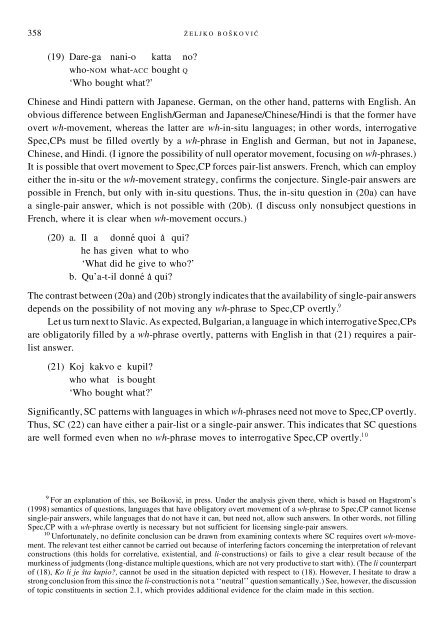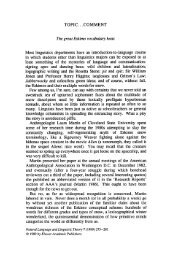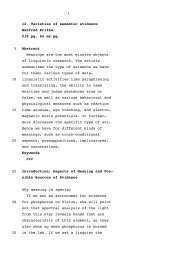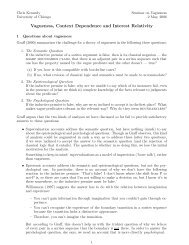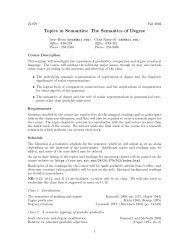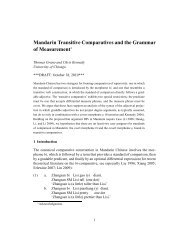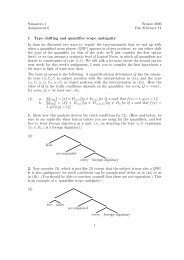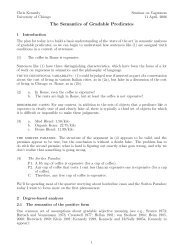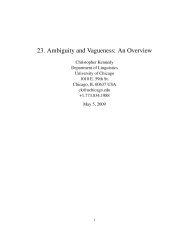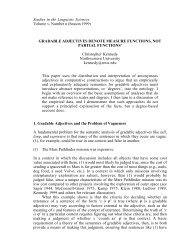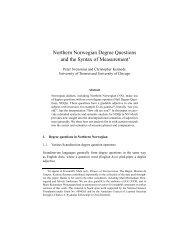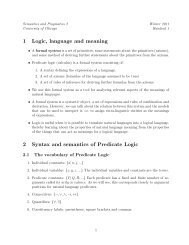On Multiple Wh-Fronting - University of Chicago
On Multiple Wh-Fronting - University of Chicago
On Multiple Wh-Fronting - University of Chicago
Create successful ePaper yourself
Turn your PDF publications into a flip-book with our unique Google optimized e-Paper software.
358 ZÏ E L J K O B O SÏ K O V I Ć(19) Dare-ga nani-o katta no?who-NOM what-ACC bought Q‘<strong>Wh</strong>o bought what?’Chinese and Hindi pattern with Japanese. German, on the other hand, patterns with English. Anobvious difference between English/German and Japanese/Chinese/Hindi is that the former haveovert wh-movement, whereas the latter are wh-in-situ languages; in other words, interrogativeSpec,CPs must be filled overtly by a wh-phrase in English and German, but not in Japanese,Chinese, and Hindi. (I ignore the possibility <strong>of</strong> null operator movement, focusing on wh-phrases.)It is possible that overt movement to Spec,CP forces pair-list answers. French, which can employeither the in-situ or the wh-movement strategy, confirms the conjecture. Single-pair answers arepossible in French, but only with in-situ questions. Thus, the in-situ question in (20a) can havea single-pair answer, which is not possible with (20b). (I discuss only nonsubject questions inFrench, where it is clear when wh-movement occurs.)(20) a. Il a donné quoi a‘ qui?he has given what to who‘<strong>Wh</strong>at did he give to who?’b. Qu’a-t-il donné a‘ qui?The contrast between (20a) and (20b) strongly indicates that the availability <strong>of</strong> single-pair answersdepends on the possibility <strong>of</strong> not moving any wh-phrase to Spec,CP overtly. 9Let us turn next to Slavic. As expected, Bulgarian,a language in which interrogativeSpec,CPsare obligatorily filled by a wh-phrase overtly, patterns with English in that (21) requires a pairlistanswer.(21) Koj kakvo e kupil?who what is bought‘<strong>Wh</strong>o bought what?’Significantly, SC patterns with languages in which wh-phrases need not move to Spec,CP overtly.Thus, SC (22) can have either a pair-list or a single-pair answer. This indicates that SC questionsare well formed even when no wh-phrase moves to interrogative Spec,CP overtly. 1 09 For an explanation <strong>of</strong> this, see BosÏ ković, in press. Under the analysis given there, which is based on Hagstrom’s(1998) semantics <strong>of</strong> questions, languages that have obligatory overt movement <strong>of</strong> a wh-phrase to Spec,CP cannot licensesingle-pair answers, while languages that do not have it can, but need not, allow such answers. In other words, not fillingSpec,CP with a wh-phrase overtly is necessary but not sufficient for licensing single-pair answers.10 Unfortunately, no definite conclusion can be drawn from examining contexts where SC requires overt wh-movement.The relevant test either cannot be carried out because <strong>of</strong> interfering factors concerning the interpretation <strong>of</strong> relevantconstructions (this holds for correlative, existential, and li-constructions) or fails to give a clear result because <strong>of</strong> themurkiness <strong>of</strong> judgments (long-distance multiple questions, which are not very productive to start with). (The li counterpart<strong>of</strong> (18), Ko li je sÏta kupio?, cannot be used in the situation depicted with respect to (18). However, I hesitate to draw astrong conclusion from this since the li-constructionis not a ‘‘neutral’’ question semantically.) See, however, the discussion<strong>of</strong> topic constituents in section 2.1, which provides additional evidence for the claim made in this section.


